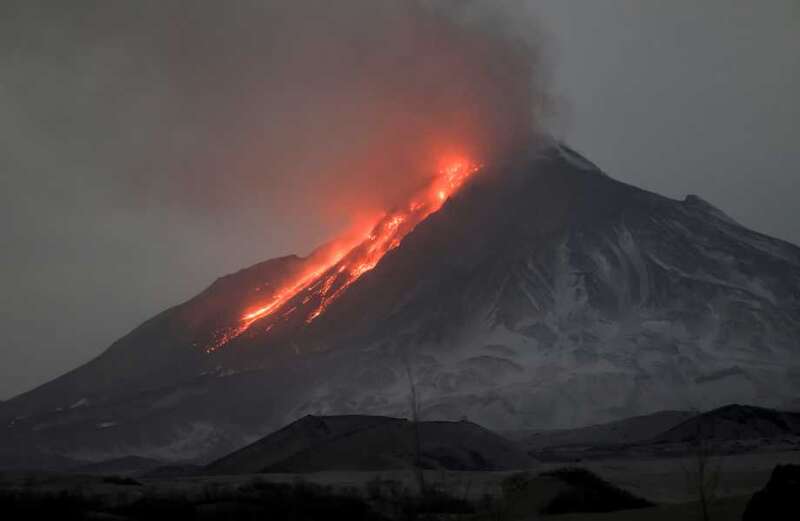A MASSIVE volcanic eruption has sent an ash cloud spiralling 12 miles into the atmosphere - a spectacle so large it was captured from space.
The Shiveluch volcano on Russia's far eastern Kamchatka Peninsula erupted today and spewed ash over 41,700 square miles triggering aviation mayhem.




Soon after midnight, lava flows tumbled from the volcano, which had been threatening to erupt for the past year.
Ash was violently thrown 12 miles into the air, which turned day into night as the dense cloud blocked out the sun.
The spectacular and frightening eruption was so powerful that it was caught by satellites in space.
 Putin accused of surrounding himself with same 'actors' at series of events
Putin accused of surrounding himself with same 'actors' at series of events
The mesmerising footage shows the moment that ash breaks apart high-flying clouds so ferociously that it could be seen among the stars.
The ash then rained down on villages and blanketed them in 3.5inch drifts of sticky grey residue - the deepest in 60 years.
Residents of the remote peninsula which is 4,225 miles east of Moscow described how the morning sky turned to darkness.
"The sun should be shining but is nowhere to be seen,” said one local.
“The village is under a cloud of ash from the Shiveluch volcano. It’s pitch dark. You cannot see anything.”
Another said: “That's it, the lights are out. No sunlight.”



The Kamchatka Volcanic Eruption Response Team issued a red notice for aviation, saying "ongoing activity could affect international and low-flying aircraft”.
The Tokyo Volcanic Ash Advisory, which monitors volcanic activity on the world's eastern flank, has also issued an advisory to airlines.
It was earlier feared that the threat to aircraft might echo the eruption of Iceland's Eyjafjallajökull volcano in 2010.
The eruption forced 16,000 flights to be cancelled in one day, closed airports around the world and became the biggest disruption to aviation since the Second World War.
 Russians wrote 'Happy New Year' on drone sent crashing into playground
Russians wrote 'Happy New Year' on drone sent crashing into playground
The Kamchatka Peninsula lies on the air routes between Asia and North America, which are some of the world's busiest.
However, Professor Bill McGuire, a volcanologist from University College London told The Sun Online that he believes the impact of Shiveluch will be far more "limited".
"The cloud is still relatively confined, so is not providing a significant threat," he says.
"When and if the cloud spreads, it is possible that it could interfere with some flights, including those over the poles, but I think any such impacts will be limited, if they happen at all."
Yet, locals felt the impact heavily. In some areas, they were ordered to stay inside and schools were shut.
"The ash reached 20 kilometres (12 miles) high, the ash cloud moved westwards and there was a very strong fall of ash on nearby villages," said Danila Chebrov, director of the Kamchatka branch of the Geophysical Survey.
Officials have confirmed that power has been restored and drinking water was being supplied.
Yet, brave residents ventured outside in hazmat suits and even played in the ash fall.
Some scientists happened to be at the crater as the volcano erupted.
Terrifying footage showed the scientists running for their lives as a dark storm of ash approached and they narrowly avoided falling molten rock.
They were forced to duck under their snowmobiles and hide there until it was safe to move.
Shiveluch is one of the world’s most active volcanoes and has had an estimated 60 substantial eruptions in the past 10,000 years, the last major one being in 2007.
It has two main parts - the smaller of which, Young Shiveluch, has been reported as being extremely active in recent months.
Shiveluch is 60,000 to 70,000 years old and has a peak of 9,186 feet that protrudes out of the 10,700 feet-high Old Shiveluch.
A spokesperson for the Met Office told The Sun Online that they are "aware of the ongoing eruption and are keeping an eye on it".
However, the zone that the eruption took place in is "outside of the Met Office's area [for monitoring] which covers London and Northern Europe, including Iceland's volcanoes".






































